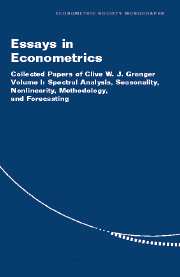Book contents
- Frontmatter
- Contents
- Acknowledgments
- List of Contributors
- Introduction
- 1 The ET Interview: Professor Clive Granger
- PART ONE SPECTRAL ANALYSIS
- PART TWO SEASONALITY
- PART THREE NONLINEARITY
- PART FOUR METHODOLOGY
- PART FIVE FORECASTING
- 17 Estimating the Probability of Flooding on a Tidal River
- 18 Prediction with a Generalized Cost of Error Function
- 19 Some Comments on the Evaluation of Economic Forecasts
- 20 The Combination of Forecasts
- 21 Invited Review: Combining Forecasts – Twenty Years Later
- 22 The Combination of Forecasts Using Changing Weights
- 23 Forecasting Transformed Series
- 24 Forecasting White Noise
- 25 Can We Improve the Perceived Quality of Economic Forecasts?
- 26 Short-Run Forecasts of Electricity Loads and Peaks
- Index
17 - Estimating the Probability of Flooding on a Tidal River
Published online by Cambridge University Press: 06 July 2010
- Frontmatter
- Contents
- Acknowledgments
- List of Contributors
- Introduction
- 1 The ET Interview: Professor Clive Granger
- PART ONE SPECTRAL ANALYSIS
- PART TWO SEASONALITY
- PART THREE NONLINEARITY
- PART FOUR METHODOLOGY
- PART FIVE FORECASTING
- 17 Estimating the Probability of Flooding on a Tidal River
- 18 Prediction with a Generalized Cost of Error Function
- 19 Some Comments on the Evaluation of Economic Forecasts
- 20 The Combination of Forecasts
- 21 Invited Review: Combining Forecasts – Twenty Years Later
- 22 The Combination of Forecasts Using Changing Weights
- 23 Forecasting Transformed Series
- 24 Forecasting White Noise
- 25 Can We Improve the Perceived Quality of Economic Forecasts?
- 26 Short-Run Forecasts of Electricity Loads and Peaks
- Index
Summary
Abstract
An estimate of the number of floods per century that can be expected at any given point of a river would obviously be an important piece of information when any expensive flood-prevention scheme is under discussion. Gumber (1958) has discussed such an estimation for a non-tidal stretch of river, and has shown how to derive estimates from existing flow data, using his method of maxima. The object of the present paper is to put forward a method of solving the intrinsically more complex problem of estimating the probability of flooding for a tidal stretch.
The mathematical theory is first briefly presented, and a generalmethod of finding the estimate is discussed. The final section is concerned with an application of the method to the River Trent at Gainsborough.
MATHEMATICAL THEORY
It has been found necessary to use a certain number of elementary statistical concepts in the following section, and for the convenience of readers unfamiliar with such concepts an examination of them will be found in the Appendix, p. 364.
Let T denote tide-height in feet at some fixed measuring point near the mouth of the river, and let F denote flow in cusec. at a point of the river which is effectively or actually non-tidal. If it is assumed that no important tributaries enter the river between the two measuring stations, it is seen that the water height H at any point on the tidal reaches will be dependent only upon T and F.
- Type
- Chapter
- Information
- Essays in EconometricsCollected Papers of Clive W. J. Granger, pp. 355 - 365Publisher: Cambridge University PressPrint publication year: 2001
- 3
- Cited by

